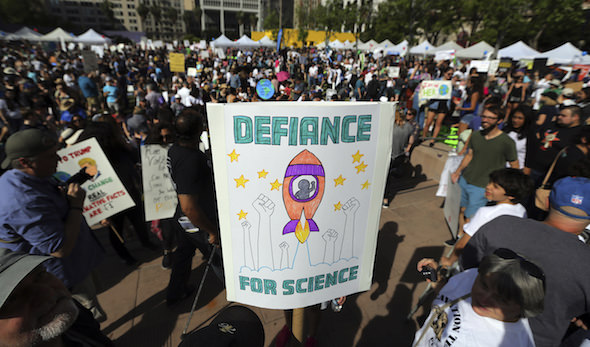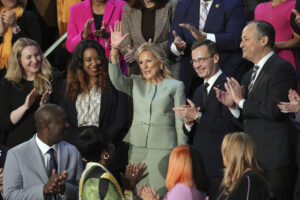Scientists Get Political—and It’s About Time
Recent steps toward a more considered political stance are helpful to both the scientific community and society at large .
Thousands rallied in downtown Los Angeles on Saturday in support of the nationwide March for Science. (Reed Saxon / AP)
Tens of thousands of people marched Saturday in more than 600 rallies and events to commemorate this year’s Earth Day.
The March for Science events were prompted by Donald Trump’s threats to withdraw from the Paris Accords and his claims that human responsibility for global warming is a “hoax.” The mobilizations were also a response to Trump’s proposed cuts in government funding for many areas of scientific research and his administration’s willful ignoring of the government’s own scientific analyses by agencies such as the Environmental Protection Agency.
It is no wonder that people in the country once considered the leading promoter of scientific research are pissed off enough to march in the streets on behalf of science.
In Los Angeles, where I live, organizers estimate that 50,000 people showed up in downtown’s Pershing Square to rally, making it one of the largest marches in the nation.
As a journalist with a science background (I have a master’s degree in astrophysics), I was excited to cover the march. My training in science prepared me well for journalism. Indeed, science is a useful tool for all citizens, including those who are not pursuing a career in the field.
Merriam-Webster defines the “scientific method” as “principles and procedures for the systematic pursuit of knowledge involving the recognition and formulation of a problem, the collection of data through observation and experiment, and the formulation and testing of hypotheses.”
Rigorous science training can help ordinary people do their own research, distinguish fake news from authentic news and see through false advertising and mainstream media bias. It can help them make sense of statistics, understand doctors and appreciate nature. In fact, most of us practice the scientific method daily without even realizing it.
If we apply the scientific method to the myriad outlandish claims made by conservatives on issues such as global warming, abortion and so-called fetal personhood, stem cell research, regulations of industrial waste, and pesticide and other chemical use, they often don’t stand up to scrutiny. As one retired water biologist’s sign at the march in Los Angeles read, “Reality has a liberal bias.”
Studies such as this one have found that the more educated people are, the more liberal they tend to be. Thirty-one percent of postgraduate degree-holders have consistently liberal views, compared with 13 percent of the general population.
At the same time, throughout history there have been those who realize that science can be wielded as a powerful weapon to further a nefarious agenda. Scientists wishing to justify racism have historically attempted to skew facts to suit their bias. Ultimately, however, more rigorous scientific analyses have undermined racist claims to conclude that there is no correlation between skin color and intelligence or ability. Similarly sexist claims have attempted to co-opt or distort science as their means of justification but ultimately been undermined by better science.
But the fields of science are hugely dominated by white men in the U.S. today, a reflection not just of our segregated K-12 educational system but also of systemic hostility that women and people of color face in academia (as I can personally attest to).
At the March for Science in Los Angeles, I spoke with several women of color who acknowledged these challenges. Wajeeha Mahmoud is a biology major at Chaffey College in Rancho Cucamonga, Calif., who was marching with several of her fellow students. The hijab-wearing young woman carried a sign that read, “This is what a scientist looks like,” and she told me, “No, there’s aren’t enough women of color in science.” Her friend, Donia Hijaz, also a hijab-wearing Muslim woman of color and a psychology major at Chaffey, said, “Unfortunately, the field of science is dominated by white males, and they make the rules.”
In addition to addressing sexism and racism within science, what drew some women of color out for the march was the president’s attacks on their identity. Jeniffer Hernandez, a professor at the Keck Graduate Institute in Claremont, Calif., was pushing her daughter in a stroller and carrying a large sign that read, “I’m a 1st Generation Mexican American Scientist, not a murderer, rapist, or drug dealer.” She told me in an interview that “I’ve felt attacked ever since Trump decided to run for president, not just as a scientist, but also [as] a woman and minority.”Hernandez is the daughter of undocumented immigrants who became citizens under Ronald Reagan’s 1986 Immigration Reform and Control Act. Motivated by her father’s Type 2 diabetes, she became a scientist who now relies on funding from the National Institutes of Health, which Trump has targeted for cuts. The March for Science was Hernandez’s first time at a political event, and she told me it wouldn’t be her last. “Science is very important, and it’s being attacked and I need to defend it,” she said.
But when I asked one space plasma physicist, a white man named Drew, whether it’s time for scientists to become politically active, he said, “That’s a difficult question. Science is supposed to be nonpartisan and unbiased by its very nature.” He said he debated going to the march because “politicizing science is a very dangerous and slippery slope.” He added, “Unfortunately, now we’re being forced to pick sides.”
In truth, science funding is not as nonpartisan as we would like to think. Lawmakers have great discretion over which fields get funded and to what extent.
Like nearly every other field that is publicly funded, scientific research cannot remain immune from political influence just because it aspires to logic and rationality. As women and people of color have experienced firsthand, human biases creep into decision-making all the time — even decisions made by scientists.
Many great scientists have expressed political views, including Albert Einstein and Stephen Hawking. The issue of climate change in particular has compelled high-profile scientists to speak out. These include former NASA scientist James Hansen, Neil deGrasse Tyson and Bill Nye the Science Guy, who headlined the Washington, D.C., March for Science. And for years, members of the Union of Concerned Scientists have done advocacy work to harness science for the greater public good.
It was heartening to see so many scientists mobilize politically at the March for Science, even if it was their first-ever political action. It is tempting to think that engaging in noble work that benefits humanity is enough and ought to stand on its own merit. But none of us is immune to the devastating effects of climate change and the threats to our water, air and food that Trump and his party promise to realize. In our current political climate, we need all hands on deck.
Independent journalism is under threat and overshadowed by heavily funded mainstream media.
You can help level the playing field. Become a member.
Your tax-deductible contribution keeps us digging beneath the headlines to give you thought-provoking, investigative reporting and analysis that unearths what's really happening- without compromise.
Give today to support our courageous, independent journalists.






You need to be a supporter to comment.
There are currently no responses to this article.
Be the first to respond.